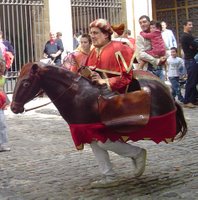The chemist Wilbur Scoville from Park David Pharmaceutical Company, has run several investigations that demonstrate chilies contain capsaicin, a chemical component that stimulates the secretion of endorphins, which generates a sentiment of euphoria in the person who eats it.
As we all know, chilies (with its capsaicin component) are central in Mexican food, which can help to explain the success of Mexican food around the world.
Saturday night, María Luisa, one of my classmates from my masters program invited us to experiment this distinct flavor of authentic Mexican food at her home in the center of Iturrama, in Pamplona, Spain.
Everything was there. She had prepared tacos, quesadillas, green salsa, chips, meat with peppers… even tequila!.
The night started rather slow, but as we began to eat, the group started to cheer up and we ended up singing and dancing in the center of the living room.
I am not sure if it was the chemical effect of the chilies, a tequila effect, or the sensation of eating great food in good company. But there is not doubt that it had been a while since I had such a great time.
Showing posts with label Pamplona. Show all posts
Showing posts with label Pamplona. Show all posts
Sunday, December 03, 2006
Tuesday, November 28, 2006
Japanese Birthday Party: Not Just a Regular Party
Few things are as common as birthday parties. After all, we have birthdays every year, and generally, we celebrate it every year as well.
However, last week I received an unusual invitation for a Japanese Birthday Party.
After I received the invitation through an sms, an avalanche of questions ran through my head: How do Japanese people celebrate their birthdays? Will the birthday boy cook Japanese food for everyone or will he choose to serve Mediterranean food now that he is living is Spain? What will be the atmosphere like? Will there be a lot of people present?
As soon as I got the message, I tried to persuade some of my friends to accompany me to the reunion. However, I was unsuccessful.
In a different situation, I wouldn’t have gone to the party. But this time, my curious instinct was stronger than me. Even if I had to go by myself, there was no way I was going to miss that party: I had to experience how Japanese people celebrated their birthdays.
When I got to the party, the birthday boy was still cooking. Despite the fact there were not many people present at that time, judging from the amount of food on the table, I could sense it was going to be a big celebration.
After little time, the place started to fill up. I never imagined that we were going to be so many… and so many people from so many different countries.
There were people from Japan, Taiwan, Paraguay, Colombia, Germany, England, Spain… and surprisingly, everyone interacted with each other without problem.
This surprised me because many times when we organize reunions, we feel uncomfortable about inviting people from different groups because we are afraid they won’t get along, or they won’t find something to talk about.
However, it seems like Japanese people are more concerned about not leaving anyone out, and utilize they cordial ways, generosity and amiability to create a friendly atmosphere where everyone can get along.
That night I enjoyed myself meeting new people, trying new dishes (from Japanese to Spanish and Latin, sweet and salty, vegetarians and with meat).
It seems like in Japanese parties diversity is the key to success.
However, last week I received an unusual invitation for a Japanese Birthday Party.
After I received the invitation through an sms, an avalanche of questions ran through my head: How do Japanese people celebrate their birthdays? Will the birthday boy cook Japanese food for everyone or will he choose to serve Mediterranean food now that he is living is Spain? What will be the atmosphere like? Will there be a lot of people present?
As soon as I got the message, I tried to persuade some of my friends to accompany me to the reunion. However, I was unsuccessful.
In a different situation, I wouldn’t have gone to the party. But this time, my curious instinct was stronger than me. Even if I had to go by myself, there was no way I was going to miss that party: I had to experience how Japanese people celebrated their birthdays.
When I got to the party, the birthday boy was still cooking. Despite the fact there were not many people present at that time, judging from the amount of food on the table, I could sense it was going to be a big celebration.
After little time, the place started to fill up. I never imagined that we were going to be so many… and so many people from so many different countries.
There were people from Japan, Taiwan, Paraguay, Colombia, Germany, England, Spain… and surprisingly, everyone interacted with each other without problem.
This surprised me because many times when we organize reunions, we feel uncomfortable about inviting people from different groups because we are afraid they won’t get along, or they won’t find something to talk about.
However, it seems like Japanese people are more concerned about not leaving anyone out, and utilize they cordial ways, generosity and amiability to create a friendly atmosphere where everyone can get along.
That night I enjoyed myself meeting new people, trying new dishes (from Japanese to Spanish and Latin, sweet and salty, vegetarians and with meat).
It seems like in Japanese parties diversity is the key to success.
Pamplona: More Than a Gray City

Before I went to Pamplona, my friends and acquaintances talked about a gray city and cold city with wide streets.
No one had mentioned its horizons covered with mountains or its sunsets painted with pinkish violets and enraged yellows. No one talked about the Sadar River that runs through the South of the city appeasing the area, nor the copper and golden rugs of leaves that covers the forest tracks in the Autumn.
No one pointed out any of these secrets that the citizens of Pamplona have the pleasure of enjoying every day.
To eternalize these treasures, I decided to dedicate a little moment to them. After all, Pamplona is a lot more than the gray city that many people talk about.
Friday, November 24, 2006
An Afternoon Snack with Arepas in Pamplona
We rarely decline an invitation to go out to eat. While in Spain, an invitation to eat arepas is irresistible.
I arrived to my friend's house ready to eat a couple of delicious arepas made out of corn flour filled with queese, chorizo, or "carne mechada."
However, when I entered the kitchen I found a pile of round circles that resembled Mexican tortillas rather than the arepas that I had in mind.
After overcoming the inicial shock (I was only aware of the existense of one type of arepas), the lady of the house taught me how to eat this Colombian arepa: I had to place the toppings on top of the arepa and eat it like a toast.
Surprisingly, it didn’t only look different, but it tasted different as well, even though it was prepared with the same ingredients. Different, peculiar, but equality delicious.
The hot chocolate that the lady served us was different to the one that I was used to drink: This one had pieces of cheese inside of it that melted with the heat of the beverage!
On one hand, I loved the new type of arepas. But on the other, I think I will stick to the traditional hot chocolate recipe that excludes the cheese.
Nevertheless, I raise my glass, make a toss and thank the hostess for the afternoon snack!
I arrived to my friend's house ready to eat a couple of delicious arepas made out of corn flour filled with queese, chorizo, or "carne mechada."
However, when I entered the kitchen I found a pile of round circles that resembled Mexican tortillas rather than the arepas that I had in mind.
After overcoming the inicial shock (I was only aware of the existense of one type of arepas), the lady of the house taught me how to eat this Colombian arepa: I had to place the toppings on top of the arepa and eat it like a toast.
Surprisingly, it didn’t only look different, but it tasted different as well, even though it was prepared with the same ingredients. Different, peculiar, but equality delicious.
The hot chocolate that the lady served us was different to the one that I was used to drink: This one had pieces of cheese inside of it that melted with the heat of the beverage!
On one hand, I loved the new type of arepas. But on the other, I think I will stick to the traditional hot chocolate recipe that excludes the cheese.
Nevertheless, I raise my glass, make a toss and thank the hostess for the afternoon snack!
Wednesday, October 18, 2006
Pamplona Does not only Dress Up for San Fermines
 Outside of Spain, Pamplona only makes news in July, when Panplonenses wear their festive white clothes adorned with red scarves and hankerchiefs to give a toss during el chupinazo and run in the encierro of San Fermines.
Outside of Spain, Pamplona only makes news in July, when Panplonenses wear their festive white clothes adorned with red scarves and hankerchiefs to give a toss during el chupinazo and run in the encierro of San Fermines.Nevertheless, to my surprise, when I arrived at Pamplona in September, The city welcomed me with a party!
Bored, newly arrived to the city, and with nothing to do, I decided to go for a walk to get to know my new “home”, and found tons of people out in the streets. At the beginning, I was surprised. But then I rationalized that locals probably used Sundays afternoons to walk around town as a family.
However, it did not take long for me to discover I was mistaken.

Kids, grandparents and entire families ran along the streets trying to avoid the blows of rubber cachirorras given by men dressed in horse suits.
In the piazzas, dancers jumped and turned with handkerchiefs and baskets showcasing the traditional dances as they were cheered on by the spectator’s enthusiastic claps.
 Along the streets, people’s voices were sporadically replaced by the tunes of the charanga’s(photo 3) clarinets and drums that announced the parade of “Gigantes y Cabezones” (photo 4), people dressed with giant paper mache heads that represented different public figures.
Along the streets, people’s voices were sporadically replaced by the tunes of the charanga’s(photo 3) clarinets and drums that announced the parade of “Gigantes y Cabezones” (photo 4), people dressed with giant paper mache heads that represented different public figures. It was definitely not a normal weekend.
 Pamplonenses’ were celebrating the “Small Parties”, a reduced version of San Fermines that allows locals to maintain the tradition and enjoy the celebration without the tourists, even though at this event the emblematic bulls are absent.
Pamplonenses’ were celebrating the “Small Parties”, a reduced version of San Fermines that allows locals to maintain the tradition and enjoy the celebration without the tourists, even though at this event the emblematic bulls are absent. Even though Pamplona only makes news in July, its locals know how to have fun all year round.
For more information about Pamplona, Spain, and San Fermines, visit Pamplona’s official website.
Subscribe to:
Posts (Atom)

